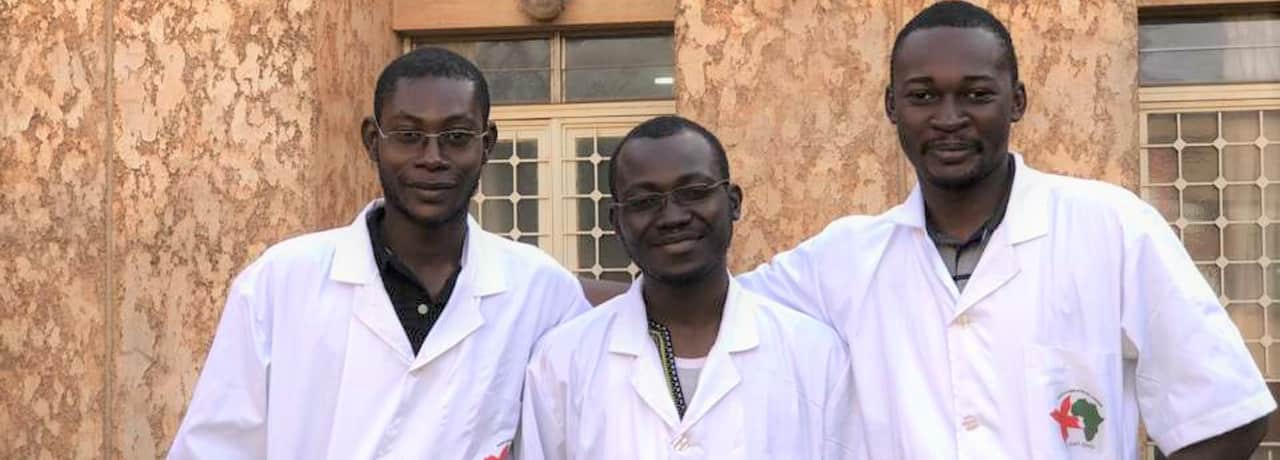September 17, 2019

Related Blogs:
Sign up for blog updates
Get innovation delivered to your inbox. Sign up for our blog and stay on top of the very latest from Semtech (formerly Sierra Wireless).
September 17, 2019

Christian Cedric Toe – a recent winner of our mangOH Yellow IoT development contest who will be speaking at our Innovation Summit in Paris, France this October – wanted to address this problem head on. We sat down with the Burkina Faso-based engineer recently to discuss his Laafi Bag, a thermo-regulated backpack that is designed to keep vaccines properly refrigerated for up to four days as they are transported to rural towns and villages.
Christian Cedric: Unlike most pharmaceuticals and other medicines, which have some flexibility in the temperatures they can tolerate, many vaccines need to be kept at a temperature between 2℃ (36℉) – 8℃ (46℉). If they aren’t kept within their recommended storage temperature, their effectiveness and potency can be significantly reduced, or even negated. As a result, when the vaccine is administered, it may no longer offer protection against the disease it’s supposed to be vaccinating against.
Christian Cedric: Most of the vaccines – polio, meningitis A, HPV, and so on – are stored in the capital city. If there’s a vaccination drive under way, vaccines are transported from the capital to a local storage facility in one of Burkina Faso’s 45 states, and from that local storage facility out to local hospitals. From there, the vaccines then need to travel to the villages that the hospital serves, which can be up to 25 kilometers away from the hospital.
It’s that last leg of the journey that is most difficult when it comes to maintaining and monitoring the cold chain for the vaccines. The vaccination agents who are in charge of delivering the vaccines currently use coolers – filled with ice, liquid coolants, or other types of cold packs – to keep the vaccines cold. But every time a cooler’s lid is opened – for example, because they’ve arrived in the field and are taking vaccines out of the cooler to administer them to villagers – the temperature can rise. In addition, if the lid on a cooler is not tightly closed, the temperature in the cooler can rise as well – and the vaccination agent might not even realize it. Even when the cooler is kept closed and the lid is shut, if the ambient temperature outside gets very hot, the temperature inside the cooler might rise above the level needed to keep the vaccines effective. In Burkina Faso, temperatures can regularly climb as high as 45℃ (113℉), so this is a real concern.
Meanwhile, both the vaccination agents who are distributing the vaccines and the authorities who are in charge of the vaccination campaigns have no way of monitoring the temperature of the vaccines as they are in transit from the local hospitals to the villages, on the final stage of their journey to being administered.
Christian Cedric: The Laafi Bag is designed to keep vaccines at the right temperature for more than 90 hours – but it isn’t just a passive piece of hardware like a cooler. It actively monitors the temperature within the bag and can adjust the temperature if it senses the vaccines are getting too warm. So, even if a user opens the bag 20 times to administer a polio vaccine, or outside ambient temperatures spike, the bag will regulate itself and bring temperatures in the Laafi Bag back to the proper range. In addition, it informs both the person transporting the vaccine, and the vaccination program administrators, of the temperature in the backpack throughout its journey – so that, together, they can ensure that vaccines stay at the proper temperature.
Also, as a backpack, the Laafi Bag is much easier to transport to remote places than a large box, like a cooler. Since vaccination agents often must travel to villages on foot or motorbike, this portability can be very beneficial.
Christian Cedric: In addition to the initial research and development in Burkina Faso, I was privileged to spend three months in New York City earlier this year at the NYDesign Startup Incubator at LaGuardia Community College, where I was greatly assisted by Joseph Puma, whose support was extremely helpful.
At this point, we still have some technology study, programming, platform integration, and field tests to do. We hope to complete all this in around three months, at which point we will have a fully working model of the Laafi Bag completed.
Christian Cedric: People often underestimate the potential for the IoT to drive growth in West Africa. For example, though we are a developing country, in Burkina Faso we have leapfrogged past analog technologies, and today many of our citizens are “digital natives.” In addition, the economy here is growing at 6% per year, and there’s a rapidly expanding middle class. A lot of West Africa is like this – and there’s a huge opportunity here for healthcare, agricultural, and other IoT solutions that can be used to further accelerate this growth. If you are an IoT company (or investor), I would say: if you are not looking at West Africa, you are missing out on an important market.
Intrigued? You can hear more from Christian Cedric about his invention – and learn about other innovative new IoT applications – at the Innovation Summit October 22-23, in Paris.
In the meantime, remember to Start with Sierra if you are seeking to turn your innovative idea (like the Laafi Bag) into a commercial product that uses the IoT to solve a difficult real-world problem.
Get innovation delivered to your inbox. Sign up for our blog and stay on top of the very latest from Semtech (formerly Sierra Wireless).